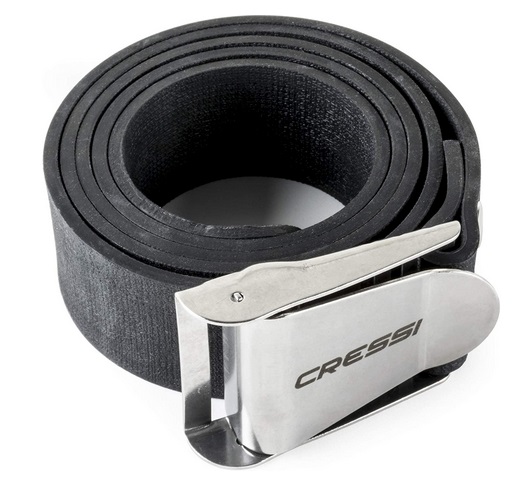Due to our Body and especially due to the positive buoyancy of the Wetsuit, Scuba Divers must use a scuba diving weight belt and weights to be able to descend.
There are different forms of weight belts
- regular weight belts
- soft pocket weight belts
- rubber weight belts
- ankle weight belts
- Harness weight belts
- BCD integrated weight system
and all are used for different forms of scuba diving.

Length & Width
The weight belt comes in a prefabricated length of usually 60″ inch or 152 cm. Make sure that it is not too short by measuring your waist circumference and of course include the thickness of the wetsuit and the weights as you need a lot of length to thread them in.
The width is 2″ inch or 5 cm.

Trimming a weight belt
To cut the weight belt to the correct length you will need a sharp knife or scissors, a lighter and something to seal the end after heating. You can also do this with your fingers, but be careful because you can easily burn your fingers!
What is the right length? That always depends on the diving suit that you wear, so never cut it too short. Better to leave it longer. Including suit and threaded weights, there should be at least 15″ Inch or 40cm excess length to ensure an easy quick release.

Material
There are two main materials
- Nylon (rigid) and
- Rubber (elastic)
Nylon is typically used by recreational divers. But you can use both for both.

Rubber is mostly used by freedivers because they are elastic and therefore cannot slide on the body.

Scuba Diving Weight belt buckle
The buckle should never be made of plastic – these do not hold the straps when jumping into the water, especially if they are very heavily occupied!
Therefore always use a stainless steel buckle! These won’t rust and can hold more weight.
Quick release system
Due to the excess Belt length and this belt, quick release is guaranteed in an emergency!

How much weight do I have to add?
That definitely depends on the thickness of the Wetsuit, the thicker the suit, the more lead you have to carry. It also depends on the diver’s experience.
With a 3mm shorty wetsuit it is approx. 5% of your own body weight that you have to thread on to the scuba diving weight belt.

Weight stopper
Weights are not supposed to slide, so-called weight stoppers can be placed in front of or and behind the weight.
D-Ring Weight stopper
Weight stoppers are available with D-rings so that diving equipment can also be attached to them, such as a surface marker buoy.

Laminated weights
Laminated weights are used to prevent aging from salt water and UV radiation. These also prevent various chemicals such as bases, acids, detergents and aqueous solutions to age the lead.
Lead does not come into contact with the environment. Durable rubber coating soft to touch. Non-slip. Can be attached to the belt without additional weight stoppers. No soiling or damage to the wetsuit, the swimming pool coating, or the boat.
Thanks to the anti-slip lamination, weight stoppers are not necessary.

Weight distribution on the scuba diving weight belt
There should be a little gap on the backside of the scuba diving weight belt because the back plate of the BC sits there. The weights should be attached to the side. If the weights are unequal, it is ok to place 2 on one side and 3 on the other. You won’t notice that underwater. 1 weight can also be attached to the BC Tank holder as a so-called trim weight.
Weight belts are always put on with the buckle in the left hand and the open end in your right hand in order to meet the standard of quick release with the right hand. This also applies to left-handers.

Pocket scuba divng weight belt
With a Pocket scuba divng weight belt, the pieces of lead sit in the padded pockets and are therefore not causing any pressure points.
This weight belt can be loaded with normal pieces of lead as well as with so-called soft lead

Soft lead weight
These pockets are filled with lead granulate and so fit very well to the shape of the body and due to that there are no pressure points occuring. These weight pouches are used in pouch weight belts.
Available in 1, 2, 3, 4 and 5 pound bags.

Weight belt in the style of a normal belt
These weight belts may look good, but they should be treated with caution as the quick release system is not guaranteed!
These belts are also elastic belts.

Weight integrated BCD
Nowadays, many of the BCs are equipped with weight pockets, so you no longer need a weight belt as the weights are loaded into the pockets provided on the BCD.
These weight pouches are equipped with a quick release system and are easy to discard.

Difficulty wearing a weight belt?
This is where this solution comes into play, a so-called suspender or Harness weight belt. So the weight is no longer on the hips but on the shoulders. This solution is particularly good for divers who need a lot of weight and/or the weight belt likes to slip over the hips.
The weight pockets have an integrated quick release system.
The alternative are BCDs with integrated weight pockets, but sometimes both are necessary.
The shoulder length of the suspender weight belt can be adjusted so that it can be worn underneath the BCD.
Of course, the waist belt is also adjustable in length

Lead mold for standard diving lead 1-4 lbs 1-2 kg pieces to pour yourself
Aluminum lead casting mold for self-pouring of standard diving lead weights of 1-4 lbs. If you have found enough fishing lead while diving, you can melt it down and cast it into the diving lead.
Lead melts at low temperatures. The melting point of lead is 327.5° C.
When melting lead, ensure that there is good ventilation and that no vapors are inhaled. The lead mold is made of aluminum. The melting point of aluminum is 660° C. Since it is possible to heat lead above the melting point of aluminum, the lead should not be heated above this melting point.
Lead can store heat well, so the lead mold has to be cooled down well, cooling down can be done after the lead has solidified by placing the mold in the water. After cooling down, the diving lead can be removed from the mold. When pouring again, the mold must be dry.
You might also be interested in:
This was our guide of scuba diving weight belts and its different forms! We hope you enjoyed it and if so, please share the article with your friends and family or on your social platforms and leave us a comment below with your favorite we would appreciate it a lot and you’d make the Oceans a little better! Thank you!
If you don’t want to miss any of our next Equipment guides you can sign up here for our free newsletter!
You’d like to support us in our marine protection projects, but don’t have much time?
Rescue the Ocean with your Purchase!
All income goes towards our Marine Life Conservation Projects!
Have a look at our merchandise!
Interested in joining us as a Marine Life Conservation Volunteer?
Check it out here
Another way to help us is with your donation or buy one of our merchandise items. All income from the Items sold goes to our Marine Life Conservation Projects.
You can now Donate in Cryptocurrency to support our Marine Life Conservation Projects
Are you interested in Scuba Diving? Come Join us at Poseidon Dive Center and do a Dive Course or Join us for a FunDive as a certified Diver.


